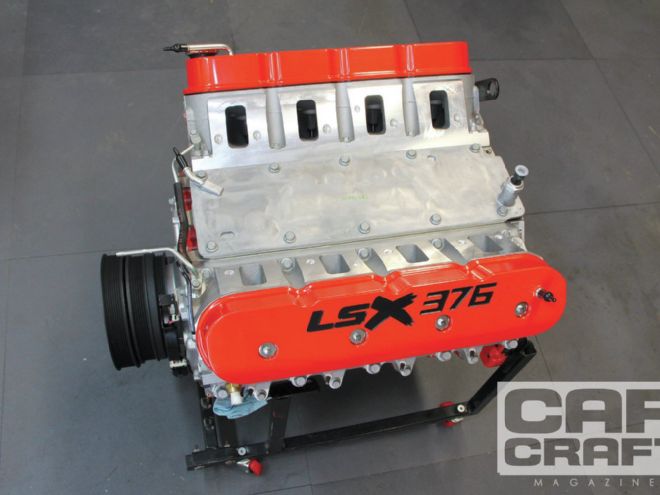
We've been trying to find the horsepower limits of the LS engine since the first supercharger kit for the 1998 Camaro, and we're not the only ones. Chevrolet Performance's Performance Marketing Manager Jamie Meyer has been watching customers pump copious amounts of boost into their racing efforts as well. With the direction of performance engineer Rocko Parker, Meyer and the team in the performance department developed a series of boost-ready engines for the Chevrolet Performance 2013 crate engine program.
The new bullets are called the LSX376-B8 and B15. You might already be aware of the LSX name for its heavy-duty block architecture that sources claim will withstand the forces generated by 2,000 hp. The number 376 is the cubic-inch displacement (6.2L) of the Corvette/Camaro LS3. The little B is for 8 pounds of boost, and the big B is for 15 pounds of boost. The critical area in a boosted application is "keeping the cylinder heads sealed," Parker says. "We are not pushing any limits, but because these long blocks carry a two-year warranty, we recommend staying at or below 15 psi."
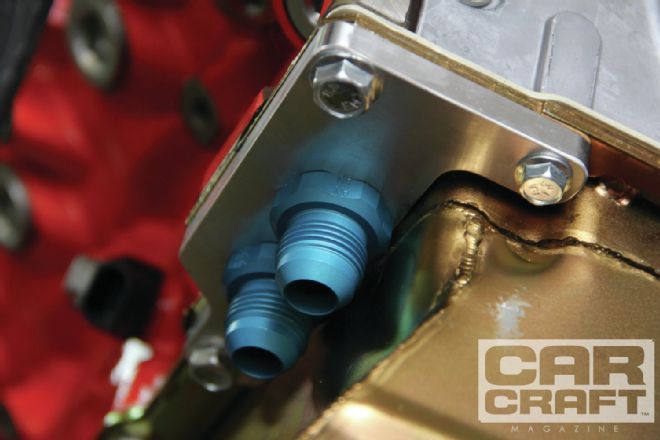 The adapter simply bolts to the pan and connects the remote oil filter adapter, using 3 feet of -10 line that is good for 300 psi and provided in the Milodon kit.
The adapter simply bolts to the pan and connects the remote oil filter adapter, using 3 feet of -10 line that is good for 300 psi and provided in the Milodon kit.
Speaking of pushing the limits, we've had our hands on an LS3 crate engine for more than five years and relied on the aftermarket to supply us with stroker cranks and dished pistons to get the factory 10.7:1 compression ratio down to something we could supercharge. We found a stroked LS3 could make 600 rwhp easily using only 6 pounds from an Edelbrock E-Force Supercharger on pump gas and still fit under a Chevelle or Camaro hood. Using turbos, it made more than 1,000, but we had to take the engine apart and upgrade the rotating assembly to do it. Stories of the engine's exploits can be found at CarCraft.com when you search for "Late Crate Update" by freelance contributor Richard Holdener.
The B15 is different. It is factory engineered for amazing boost abuse, possibly beyond what our bolt-on twin-screw and Roots toys can generate. The core of the engine is the iron LSX block with Siamesed 4.065 bores that can handle 4.200 inches and a crankcase that can handle as much as 4.250 stroke, making it similar to the LS7 block (427-inch Corvette Z06). It has the same deck height as the LS3 at 9.240 inches, so your Camaro or Corvette goodies bolt on, and it is the only cast-iron 6.2L block. Similar factory supercharged engines like the LS9 (Corvette ZR1) and LSA (Cadillac CTS-V) are made from aluminum. Metallurgy aside, what sets the LSX block apart is the additional clamping force on the head gasket provided by eight additional head bolts, something you won't find on either the factory supercharged LSA or LS9 engines. In addition, the LSX has a thicker deck, six-bolt dowel-located billet main caps, and provisions for trick racing parts like motor plates, dry sumps, and mechanical cams. Think of it as all the best parts from all the supercharged factory engines in one package.
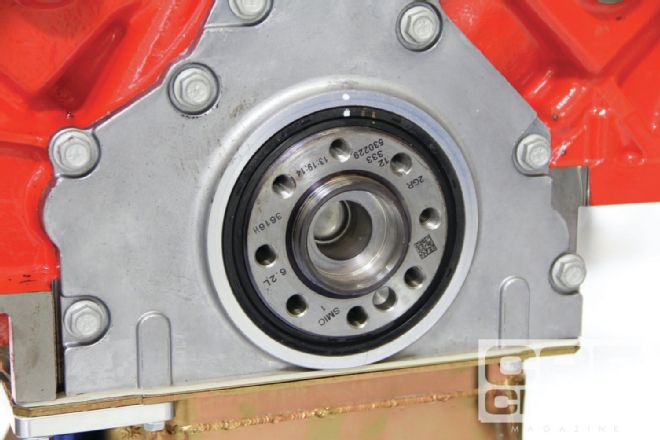 The LSA crankshaft flange has eight bolts instead of the standard six. It requires 10mm fasteners and an aftermarket flywheel.
The LSA crankshaft flange has eight bolts instead of the standard six. It requires 10mm fasteners and an aftermarket flywheel.
The rotator is also an improvement over the LS3. All LS engines have nodular iron cranks, except the LSA, LS7 (427-inch Corvette), and LS9. The B15 shares the crankshaft part number with the LSA supercharged Cadillac engine. It is made from forged steel and has a 3.62-inch stroke. The 6.098-inch rods are forged powdered metal from the LS3. The pistons are 4.065-bore, 4032 aluminum forgings with a 14cc dish that lowers the compression ratio to 9.0:1. They have a skirt coating and forced pin oiling for longevity.
That is a lot of alphabet soup. Let's review: You get an iron LSX block, an LSA supercharged crankshaft with good rods and forged pistons, special LSX/LS3 heads with an additional two bolts per cylinder, a cam, a balancer, a valvetrain, and valve covers, assembled from the factory for less than $8,000. That price is going to be hard to beat.
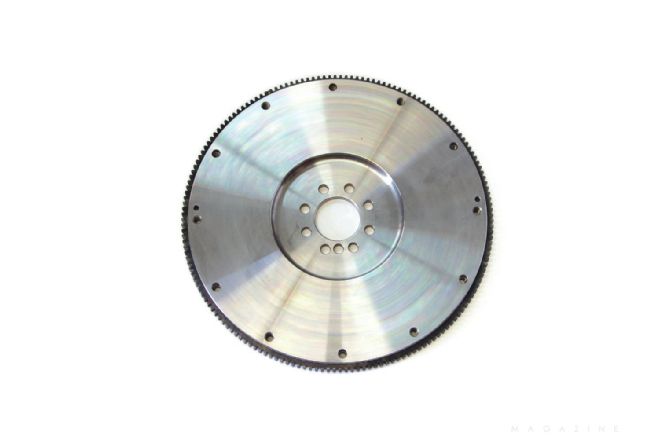 Factory LSA engines have what is called a dual-mass flywheel. To use this engine with aftermarket transmissions, you must use a single-mass flywheel like this one from McLeod.
Factory LSA engines have what is called a dual-mass flywheel. To use this engine with aftermarket transmissions, you must use a single-mass flywheel like this one from McLeod.
If you are going to run less than maximum boost, you can also buy the B8 for about $2,000 less. The primary difference is the cylinder heads. The B8 uses standard four-bolt-per-cylinder LS3 heads, forged powdered metal rods, and a nodular iron crank like the one in the LS3. You still get the same LSX block and forged pistons. The B8 is a lot more like the kind of engines we build here at Car Craft. Chevrolet Performance spent the money where it counts. The B8 should make a reliable 600–650 hp with 8 pounds of boost. The B15 should make 800–850 hp at 15 pounds. We also have the 3.5-inch Whipple pulley that makes 22 pounds. That should be good for more than 1,000—on paper, anyway.
Baseline
Using a factory LS3 manifold, the out-of-the-box B15 made almost 480 hp. The mild cam and non-ported heads kept it under 500. We aren't going to change a thing; instead, we are going to hit it with the Whipple then a set of turbos to see if 1,500 is possible from an engine you can buy from the factory.
RPM TQ HP 3,200 356 217 3,400 363 235 3,600 379 260 3,800 394 285 4,000 407 310 4,200 422 337 4,400 433 362 4,600 441 386 4,800 444 406 5,000 446 424 5,200 446 441 5,400 443 456 5,600 438 467 5,800 430 475 6,000 419 479 6,200 405 478 6,400 390 476 6,500 384 475 LSX BLOCK QUICK SPECS Type 6.2L Gen IV small-block Bore x stroke 4.065 x 3.622 Compression 9.0:1 Block LSX cast-iron Cylinder heads Cast-aluminum, rec port six-bolt LSX/LS3 Valve diameter (intake/exhaust) Hollow stem 2.16-inch/solid stem 1.59-inch Valvespring height 1.8 Chamber volume 70cc Crankshaft Forged steel undercut and rolled rod/main pins Main pin 2.56-inch Rod pin 2.10-inch Connecting rods Powdered metal w/ bronze small end Pistons Aluminum forged 4032 (14cc dish) Rings Solid steel top ring; cast-iron second; 0.025 ring gaps Wristpin Full-floating 0.943 diameter Camshaft Hydraulic roller 210/230 at 0.050 w/ 0.560/0.555-inch lift (intake/exhaust) Rocker arm ratio 1.7:1 Oil 5W30 Mobil One Maximum engine speed 6,500 rpm Firing order 1-8-7-2-6-5-4-3 PARTS LIST Description Source PN Price 105mm throttle body Accufab F105 $349.99 4.0L supercharger Whipple Superchargers WK-19060 6,499.99 Bolt kit Milodon 85002 9.25 F-body balancer ATI Performance Products 917242 435 Flywheel McLeod 460538 425 Headers Hooker 2471-1HKR 449 LSX B15 Chevrolet Performance 19299306 7,796.99* LSX B8 Chevrolet Performance 19171049 5,979.97*** LS1 installation adapter Precision Performance Products N/A 15 Oil filter Penske Cadillac 89017524 8.08 Oil Filter Kit Milodon 21575 195.97** Oil pan Milodon 30915 344.97** Oil pan gasket Penske Cadillac 12612350 39.87 Oil pickup Milodon 18290 79.97***Price from Jegs.com
**Price from SummitRacing.com
***Price from Scoggin-Dickey.com
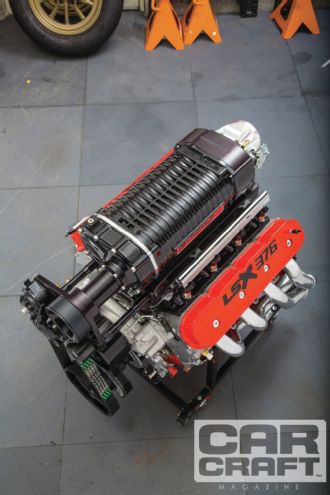 You may recognize this setup from the Late Crate Update series of stories. The 4.0L Whipple has an F-body (Camaro) offset with an 8-inch, 10-rib lower pulley bolted to an ATI balancer. Using this supercharger and a 4.75-inch pulley, we were predicting an easy 1,000 hp but deadlines prevented us from running the Whipple on the LSX in time. Don’t fear, the miracle of the Internet allows you to click on CarCraft.com and see the dyno run and power numbers by the time this goes to press. Thanks to Al Gore for inventing the Internet!*
You may recognize this setup from the Late Crate Update series of stories. The 4.0L Whipple has an F-body (Camaro) offset with an 8-inch, 10-rib lower pulley bolted to an ATI balancer. Using this supercharger and a 4.75-inch pulley, we were predicting an easy 1,000 hp but deadlines prevented us from running the Whipple on the LSX in time. Don’t fear, the miracle of the Internet allows you to click on CarCraft.com and see the dyno run and power numbers by the time this goes to press. Thanks to Al Gore for inventing the Internet!*